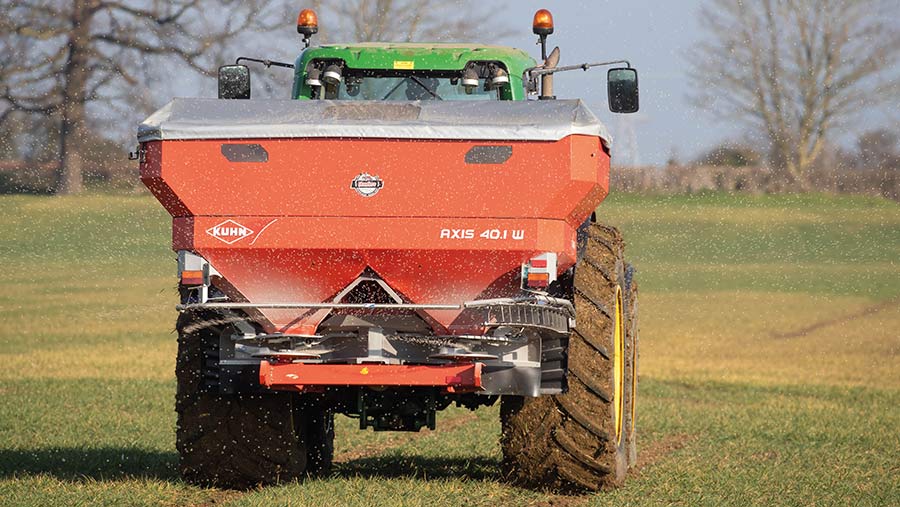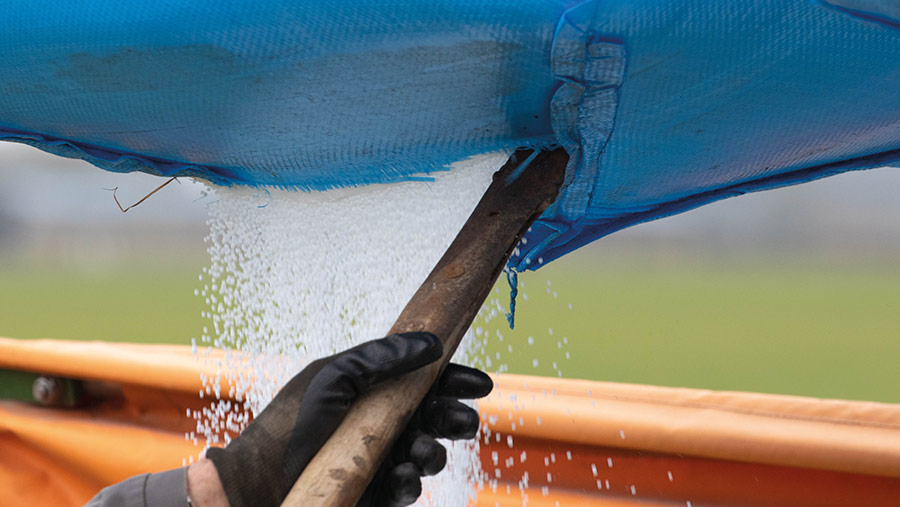Why farmers need to do their sums before altering 2023 N rates
 © Tim Scrivener
© Tim Scrivener Modest reductions in nitrogen fertiliser applications of 20-30kg/ha are being advised on most feed wheat crops for the 2023 growing season, with growers being urged to do their sums before making final decisions on fertiliser rates.
Experts agree that there will be very little effect on cereal yields from cutting back slightly, pointing out that a reduction of 25kg/ha of N results in just 0.1-0.2t/ha less yield, while a 50kg/ha cut gives an average reduction of 0.36t/ha.
See also: Digital tools may bring an end to fungicide timings
While higher fertiliser prices and a volatile grain market are concentrating minds as the growing season approaches, farmers will be reassured that the impact of reducing rates last year was minimal, they add.
Ahead of spring, the main action that growers can take is to work out the break-even ratio (BER) for each crop, says Pete Berry of agricultural consultant Adas, who says this will depend on the price of the fertiliser and the type of product to be used.
“The BER tells you how many kilos of grain is required to pay for 1kg of N,” he explains.
“Traditionally it was 5:1 for cereals and 2.5:1 for oilseed rape, but world events saw that change considerably last year to 10:1 for cereals and 4:1 for oilseed rape.”
The economic optimum nitrogen rate decreases as the BER goes up, which is why cereal growers were given guidance to reduce rates by up to 50kg/ha last year, he advises.
Rule of thumb
- For every unit increase in the BER, there should be a 10kg/ha reduction in N for wheat and barley compared with the rate recommended by AHDB’s Nutrient Management Guide, RB209
- For oats, which are more sensitive to N reductions, reduce N by 5kg/ha for each unit increase in the BER
Spring 2023
Differences between ammonium nitrate and urea prices will have a bearing in 2023, notes Dr Berry.
“If you work out the price of N for your chosen product, currently the figures are around £2.15p/kg for ammonium nitrate and £1.72p/kg for granular urea.”
Those translate to a BER of 7:1 for urea and 9:1 for ammonium nitrate at a grain price of £240/t, although the use of an inhibitor with urea will increase the urea figure by about 12p/kg, he estimates.
“You must do your sums, as it all depends on your product of choice. Bear in mind that with granular urea that doesn’t have an inhibitor included, trials have shown that you have to apply about 10% more product to get the same level of performance as you would get from ammonium nitrate.”
Dr Berry adds that strictly speaking, the BER calculation should be done using the prevailing market price of fertiliser rather than the price at the time of purchase, so that the replacement value is considered.

© Tim Scrivener
Grain markets
The unknown at this stage of the season is the grain price, says Andrew Watson, Niab’s eastern region agronomist, who advises growers to think about what their average selling price is likely to be.
At a feed wheat price of £250/t, a 25kg/ha reduction in N is relevant, he notes, but at £200/t the reduction may need to increase to 45kg/ha.
Mr Watson emphasises that there will be very little yield difference at this level of reduction, and recalls that last year’s wall-to-wall sunshine had a greater influence than slightly less nitrogen did.
“Cutting nitrogen fertiliser by 10% doesn’t cut yields by 10%,” he comments.
“Most of the yield response to nitrogen comes from the first 100kg applied – growers are familiar with the shape of the nitrogen-response curve, so it’s easy to understand that small reductions have very little effect.”
For this reason, don’t be afraid to cut N rates appropriately, he says.
Nitrogen rate reductions
Niab has prepared a table to help growers with their fertiliser decisions for 2023 (see below).
The chart shows the changes in the economic optimum nitrogen rates for feed wheat, depending on the N price and crop value.
Economic optimum N rates – feed wheat |
|||||||||
| Costs | Ammonium nitrate (£/t) | £345 | £414 | £483 | £517 | £587 | £690 | £863 | £1,035 |
| Urea (£/t) | £460 | £552 | £644 | £690 | £782 | £920 | £1,150 | £1,380 | |
| Liquid N (£/t) | £370 | £444 | £518 | £555 | £629 | £740 | £925 | £1,110 | |
| Cost (£/kg N) | £1 | £1.20 | £1.40 | £1.50 | £1.70 | £2 | £2.50 | £3 | |
| Change in applied N/ha for feed winter wheat from standard N rate of 220kg/ha | |||||||||
| Expected grain price (£/t) | £150 | -25 | -45 | -65 | -70 | -75 | -85 | -105 | -115 |
| £175 | -15 | -25 | -35 | -45 | -65 | -80 | -90 | -95 | |
| £200 | 0 | -20 | -25 | -30 | -45 | -65 | -85 | -90 | |
| £225 | 0 | -10 | -20 | -25 | -30 | -50 | -75 | -85 | |
| £250 | +10 | 0 | -10 | -20 | -25 | -35 | -65 | -80 | |
| £275 | +10 | 0 | -5 | -15 | -20 | -30 | -60 | -75 | |
| £300 | +20 | +10 | 0 | -5 | -10 | -25 | -40 | -65 | |
| Note: Ammonium nitrate 34.5% N, urea 46% N, liquid N 37% N/1,000 litres. Source: Niab | |||||||||
At the time of writing, the feed wheat price is £220/t. At a nitrogen cost of £1.70/kg, the reduction should be in the region of 30kg of N/ha.
“This is for guidance,” stresses Mr Watson. “Every farm is different, and the fertiliser buying policy and grain marketing strategy will affect what you do. But this shows why grain price movements are relevant.”
His other point is that in dry conditions, the availability of nutrients is key. “We have seen successive dry springs and products do vary in how available the nitrogen is to the plant.”
What about milling wheat?
The same thinking does not apply to milling wheats, as it’s important to hit a grain protein level of 13% for the bread-making specification.
That means keeping nitrogen rates up and using previous knowledge and experience to put on the right amount, with many farmers tracking the crop’s N status in the field.
In most cases, commentators say it will still be economically justified to target milling quality, especially if premiums are at the £40-£50/t level.
What about oilseed rape?
A different rule of thumb applies to oilseed rape crops, says Dr Berry. Last year’s advice of reducing rates by 50kg/ha was related to a BER of 4:1, he says.
“In oilseed rape, for every unit increase in BER, there should be about a 30kg/ha reduction in nitrogen rate.
“And don’t forget about the potential oil bonus when you are estimating the value of the grain.”
Mr Watson believes any changes to N rates in oilseed rape should be small. “The crop is worth too much to risk big reductions, and we are still to see the effect of pigeons and larvae in the spring.”
Calculating nitrogen requirements
With fertiliser prices so high, there is good reason to look for ways of getting the best return on your investment.
Start by estimating soil nitrogen supply (SNS), as this will give an indication of the soil’s capacity to supply nitrogen to a crop, based on previous cropping and fertiliser use, as well as soil type and winter rainfall.
“If you’re uncertain, it’s worth measuring soil mineral nitrogen (SMN),” adds Adas’ Pete Berry. “It’s important to know how much is left in the soil.”
Another relevant factor for all crops, but especially oilseed rape, is the size of the crop canopy in February.
This gives an indication of how much nitrogen is already in the crop, he explains, pointing out that crops with a large canopy at the end of winter have a greater SNS and should not need as much bagged nitrogen.
Once the SNS has been deducted from the crop-demand figure and the fertiliser-recovery percentage has been applied, an application decision can be made.
“Use your experience. Grain analysis can also be very useful, as it shows whether the crop received sufficient nutrients last year and if anything was lacking.”
Having judged the N requirement, it can then be adjusted according to the cost of the fertiliser. “This is why you must be prepared to do your sums. It’s too expensive to waste.”
Impact on yields of N reductions (t/ha) |
||
| Winter wheat | Oilseed rape | |
| 50kg of N/ha reduction | 0.36 | 0.16 |
| 100kg of N/ha reduction | 1.04 | 0.43 |
| Source: Adas | ||

